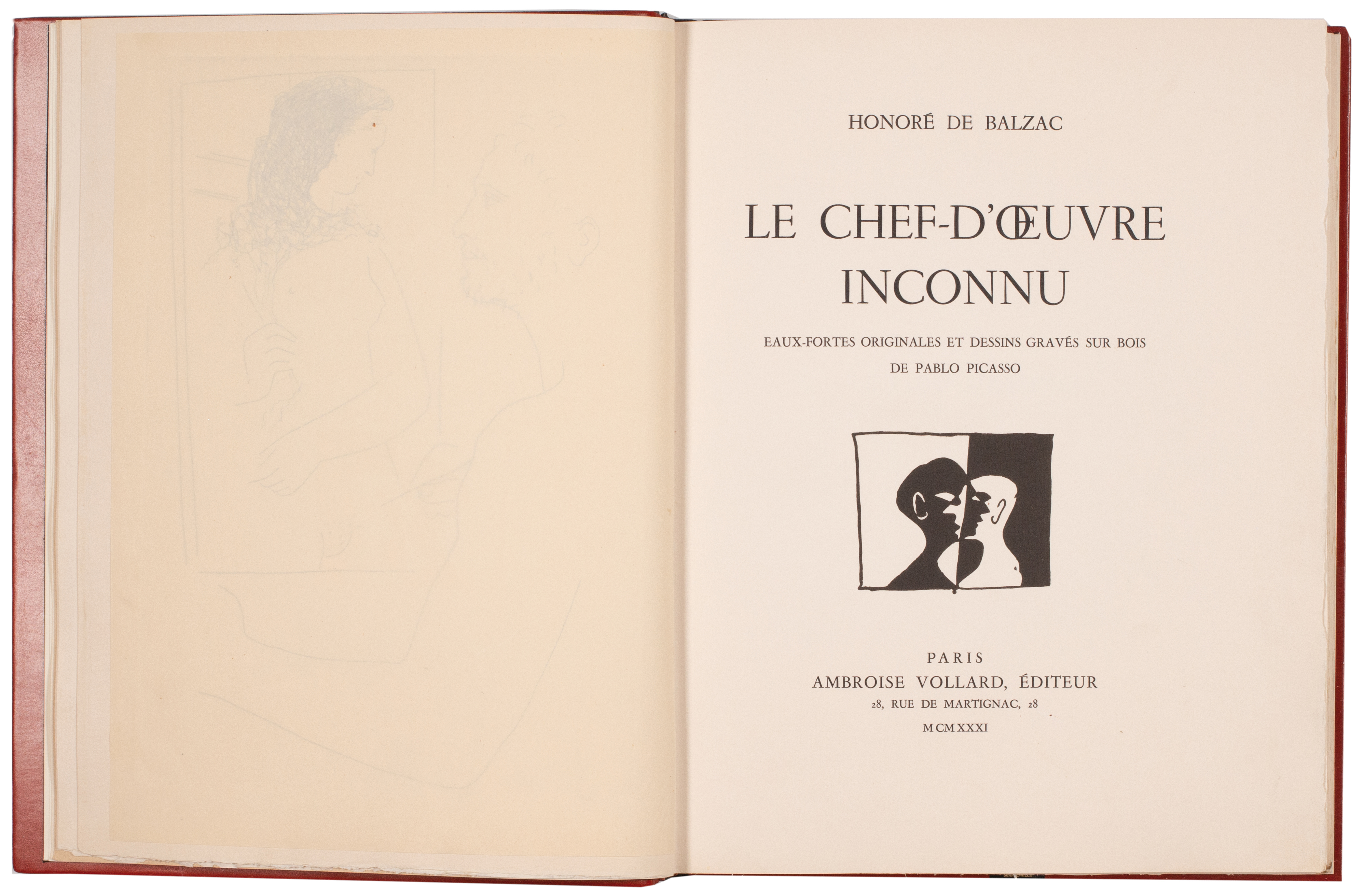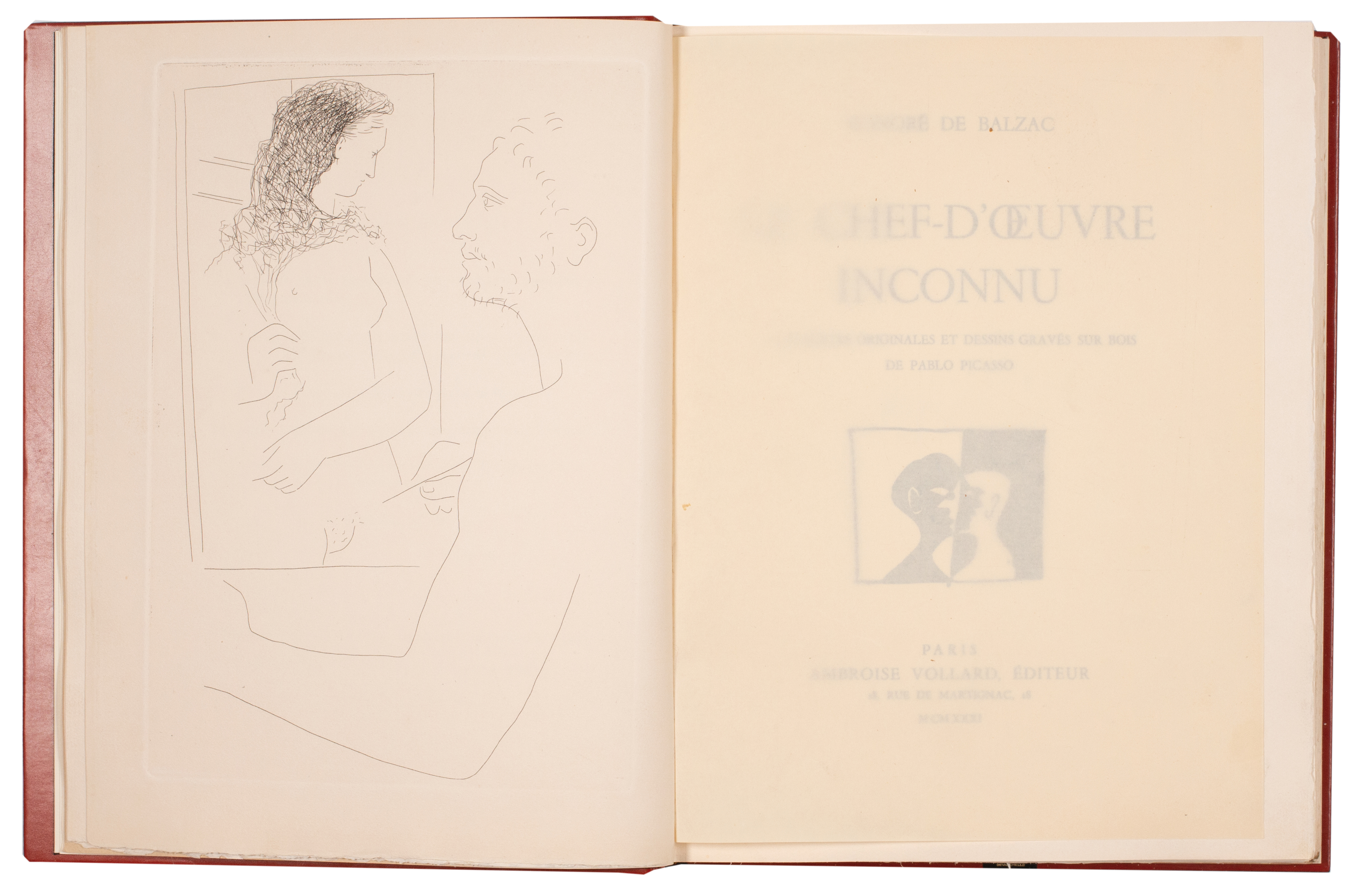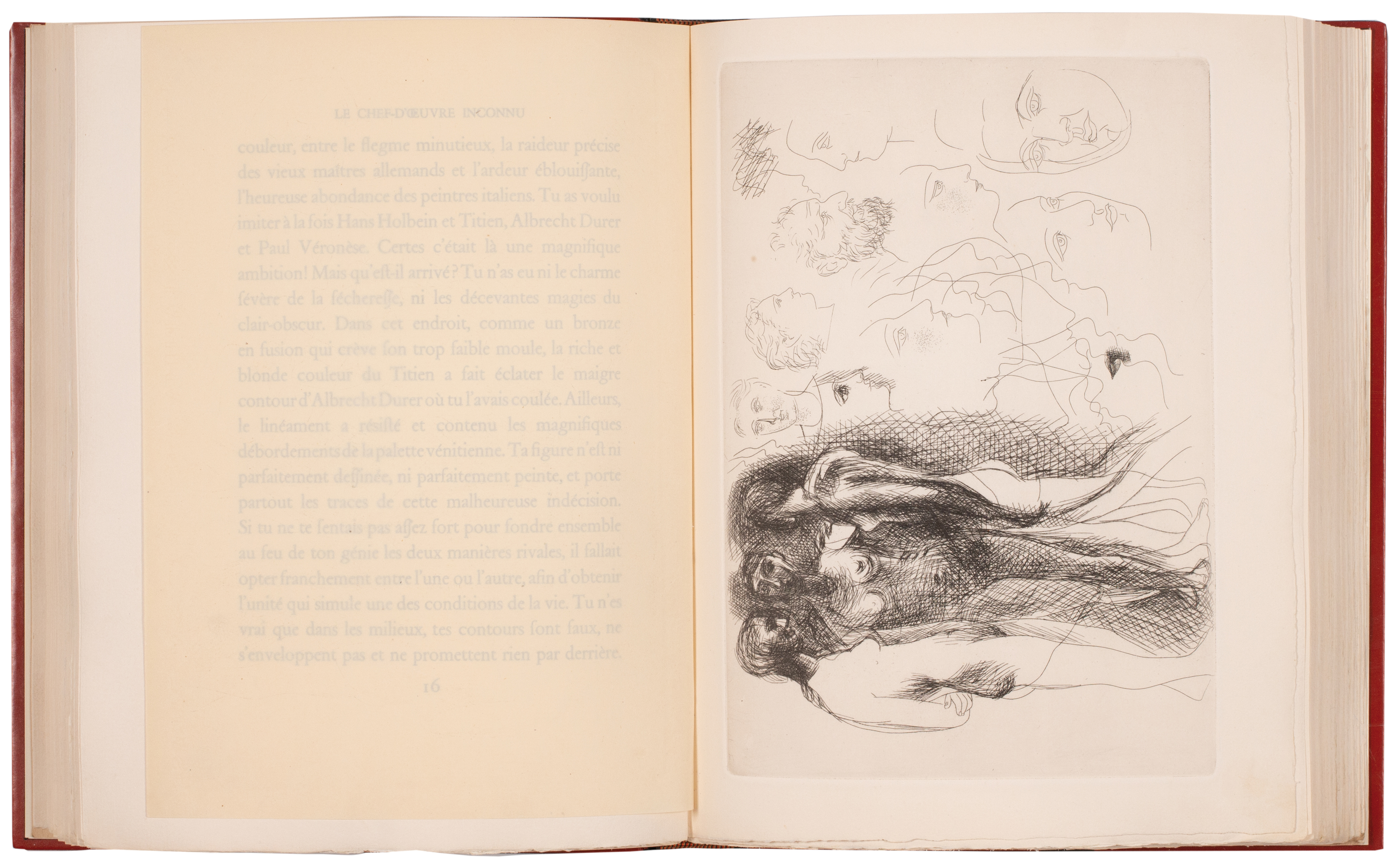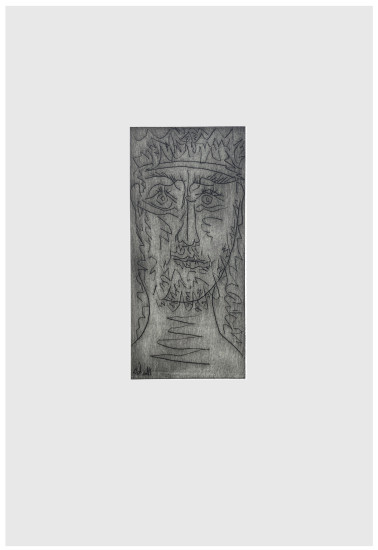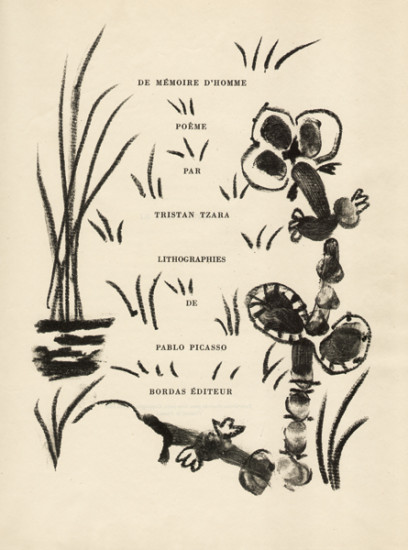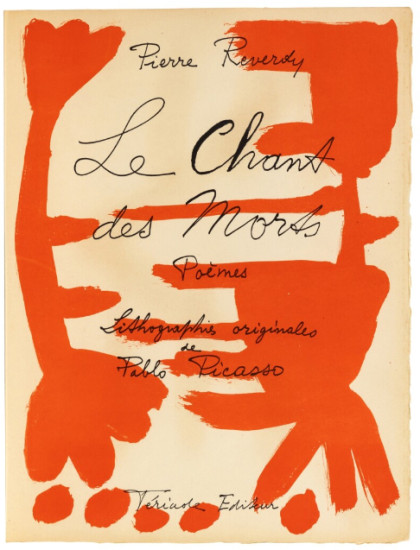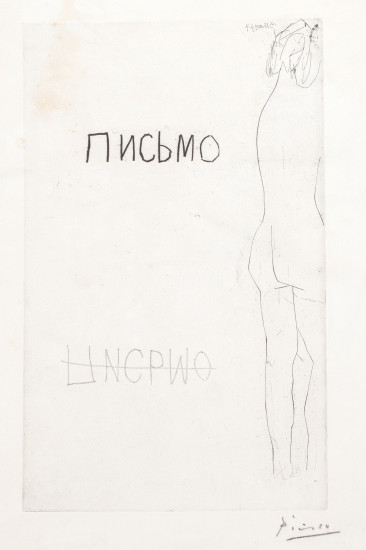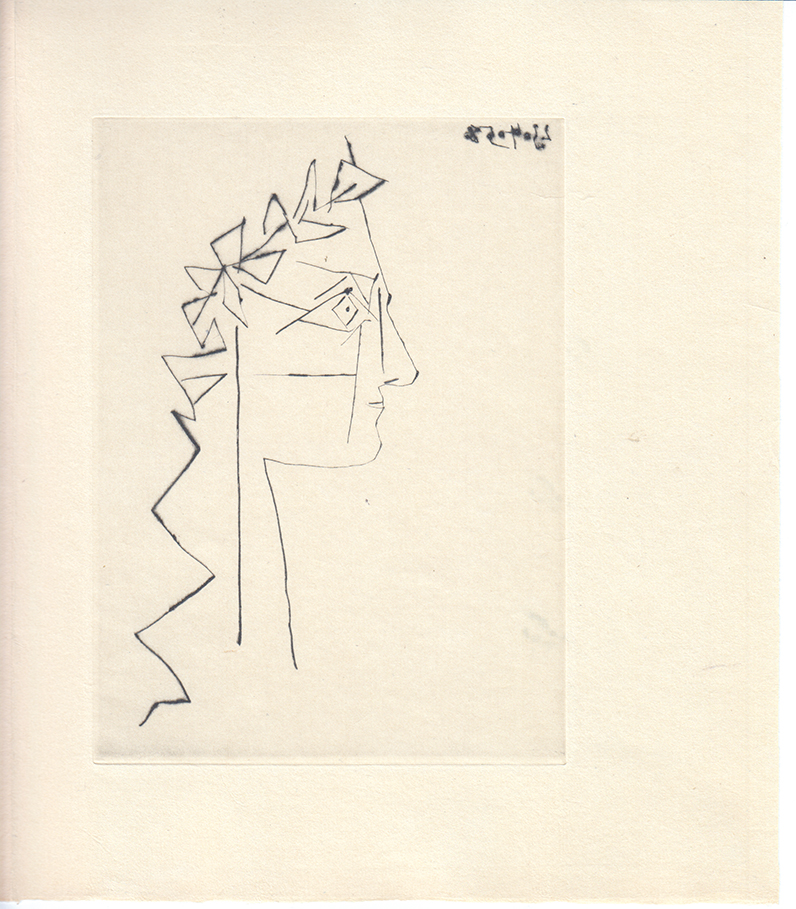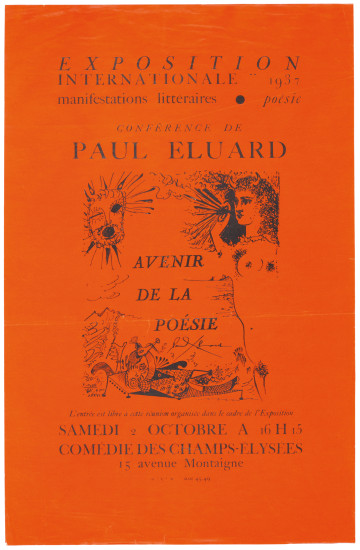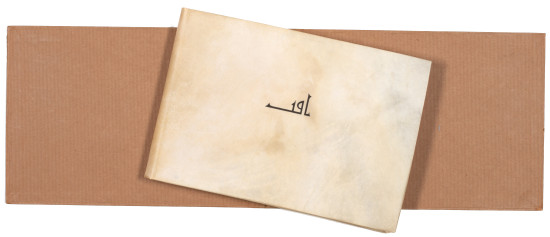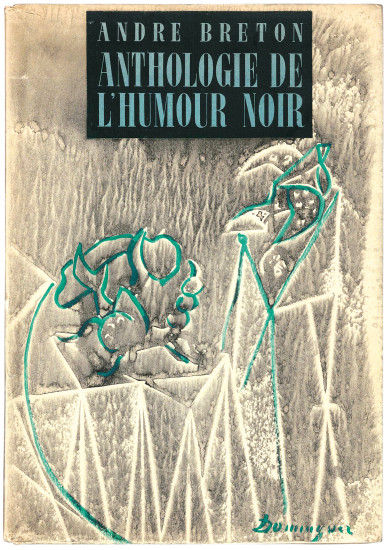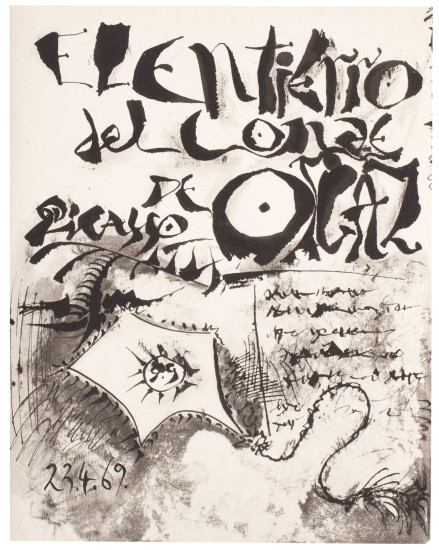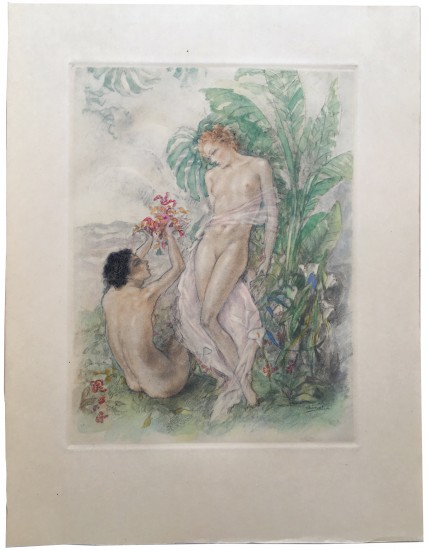Le Chef-d'Oeuvre Inconnu
Picasso, Pablo. Balzac, Honoré de
Paris. Ambroise Vollard, Editeur. 1931
Picasso's collaboration with Ambroise Vollard, his illustrations for Balzac's protean novella.
From the edition limited to 340 numbered copies, with this one of 240 on Rives.
Pablo Picasso’s first collaboration with the art dealer / publisher Ambroise Vollard takes Honoré de Balzac’s proto-Surrealist story Le Chef d’Oeuvre Inconnu (first published as Maître Frenhofer in L’Artiste in 1831 before re-publication in the same year as Cathérine Lescaut, Conte Fantastique). The tale of the fictional Old Master Frenhofer and his painting La Belle Noiseuse together with the real painters Porbus and Poussin provided Picasso and Vollard with the inspiration for an extraordinary illustrated project. Picasso’s illustrations analyse the deeper elements of Balzac’s work: the struggle of creativity, the search for inspiration, the conflicts between reason and madness, the rational and the subsconscious, realism and abstraction. The disparate illustration, ranging from the line-drawn constellations of the en manière d’introduction section, to the double-faced portrait vignettes and the large painterly original etchings – these illustrative series demonstrate affinities with Picabia’s Transparents and Miro’s Constellations - fuse in combination with Balzac’s text to make Vollard’s project a magnificent success. Le Chef d’Oeuvre Inconnu also marks Picasso’s most important and involved engagement with a text subsequent to Max Jacob’s Saint Matorel nearly thirty years before.
'Picasso's twelve etchings for Le Chef-d'Oeuvre Inconnu do not illustrate the events which take place in the story: rather, they deal with the novel's deeper meaning, especially the various elements of an artist's relationship to his model ... All the details concerning the early planning of the book are not clear. We do know that Vollard asked Picasso to illustrate Balzac's text in 1926. Picasso submitted a great number of disparate illustrations to Vollard, to whom must go the credit for having known how to adapt himself to the originality of Picasso in selecting the format, paper, and typography.' (Patrick Cramer).
‘Honoré Balzac’s text declares his aesthetic faith in artists and their search for inspiration, despite their struggles to reach their goals. The painter-protagonist Frenhofer is torn between the activity of creation and the desire for perfection that fatally undermines his ability to complete his ‘masterpiece’.’ (Logan Collection).
Le Chef d'Oeuvre Inconnu and Les Metamorphoses, both published in the same year, 1931, are the first of Picasso's major projects in illustrated books. Les Metamorphoses has 30 etchings, and this work 13, whilst the most prints any of his earlier books had were 4 etchings, in St. Matorel. Le Chef d'Oeuvre also looks forward to the Vollard suite which Picasso was about to start. In fact, this book is Picasso's first collaboration with Vollard.
In 1937 Picasso had the opportunity of setting up his atelier in … the rue des Grands-Augustins where in Balzac’s novel, Frenhofer had met the young Poussin ‘towards the end of 1612’. Brassaï recalls that ‘moved and stimulated by the idea of taking the place of Frenhofer’s illustrious shadow, Picasso rented the atelier at once’. He was to paint Guernica there. (Cramer).
[Cramer 20; Logan 54; The Artist and the Book 225].
From the edition limited to 340 numbered copies, with this one of 240 on Rives.
Pablo Picasso’s first collaboration with the art dealer / publisher Ambroise Vollard takes Honoré de Balzac’s proto-Surrealist story Le Chef d’Oeuvre Inconnu (first published as Maître Frenhofer in L’Artiste in 1831 before re-publication in the same year as Cathérine Lescaut, Conte Fantastique). The tale of the fictional Old Master Frenhofer and his painting La Belle Noiseuse together with the real painters Porbus and Poussin provided Picasso and Vollard with the inspiration for an extraordinary illustrated project. Picasso’s illustrations analyse the deeper elements of Balzac’s work: the struggle of creativity, the search for inspiration, the conflicts between reason and madness, the rational and the subsconscious, realism and abstraction. The disparate illustration, ranging from the line-drawn constellations of the en manière d’introduction section, to the double-faced portrait vignettes and the large painterly original etchings – these illustrative series demonstrate affinities with Picabia’s Transparents and Miro’s Constellations - fuse in combination with Balzac’s text to make Vollard’s project a magnificent success. Le Chef d’Oeuvre Inconnu also marks Picasso’s most important and involved engagement with a text subsequent to Max Jacob’s Saint Matorel nearly thirty years before.
'Picasso's twelve etchings for Le Chef-d'Oeuvre Inconnu do not illustrate the events which take place in the story: rather, they deal with the novel's deeper meaning, especially the various elements of an artist's relationship to his model ... All the details concerning the early planning of the book are not clear. We do know that Vollard asked Picasso to illustrate Balzac's text in 1926. Picasso submitted a great number of disparate illustrations to Vollard, to whom must go the credit for having known how to adapt himself to the originality of Picasso in selecting the format, paper, and typography.' (Patrick Cramer).
‘Honoré Balzac’s text declares his aesthetic faith in artists and their search for inspiration, despite their struggles to reach their goals. The painter-protagonist Frenhofer is torn between the activity of creation and the desire for perfection that fatally undermines his ability to complete his ‘masterpiece’.’ (Logan Collection).
Le Chef d'Oeuvre Inconnu and Les Metamorphoses, both published in the same year, 1931, are the first of Picasso's major projects in illustrated books. Les Metamorphoses has 30 etchings, and this work 13, whilst the most prints any of his earlier books had were 4 etchings, in St. Matorel. Le Chef d'Oeuvre also looks forward to the Vollard suite which Picasso was about to start. In fact, this book is Picasso's first collaboration with Vollard.
In 1937 Picasso had the opportunity of setting up his atelier in … the rue des Grands-Augustins where in Balzac’s novel, Frenhofer had met the young Poussin ‘towards the end of 1612’. Brassaï recalls that ‘moved and stimulated by the idea of taking the place of Frenhofer’s illustrious shadow, Picasso rented the atelier at once’. He was to paint Guernica there. (Cramer).
[Cramer 20; Logan 54; The Artist and the Book 225].
[83 leaves including 13 original etchings; pp. xv, A-P, 92, (iii), (i), (iii)]. Folio. (328 x 262 mm). Half-title with justification verso, printed title with monochrome vignette after Picasso, 'Avant-Propos' by Albert Besnard dated '14 Octobre 1927', nine leaves with illustrated 'En Manière d'Introduction par Pablo Picasso' (see below) and Balzac's text illustrated with 13 original etchings by Picasso and numerous vignettes, leaf with 'Avis au Relieur', 'Table' and final leaf with achevé d'imprimer; the final etching is Picasso's illustrated index of the etchings. Full black crushed morocco by Devauchelle with his signature gilt to rear doublure, gilt title to spine, doublures of claret polished calf, black silk endpapers, original publisher's tan printed wrappers with titles and vignette after Picasso to front cover and backstrip preserved, t.e.g., marbled board slipcase.
#48575
